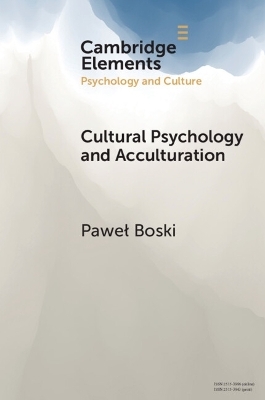
Cultural Psychology and Acculturation
Seiten
2024
Cambridge University Press (Verlag)
978-1-009-45110-9 (ISBN)
Cambridge University Press (Verlag)
978-1-009-45110-9 (ISBN)
This Element offers a new theoretical model of acculturation within the general framework of cultural psychology. Three interconnected components symbols, language, and values/practices characterize both enculturation and acculturation. Reaching bicultural competencies and identities is the proposed outcome.
This Element offers a new theoretical model of acculturation within the general framework of cultural psychology. It is divided into four sections. First, cross-cultural and cultural orientations are contrasted. The psychology of economic migration (EARN), separate from the psychology of acculturation (LEARN), is the theme of the next section. Berry's model of acculturation preferences is discussed in section three. It serves as a contrasting reference point for the tripartite model of bicultural competencies, developed in the final section. The three interconnected components are symbols, language, and values/practices characterize both enculturation and acculturation. As a second culture learning process, acculturation is not restricted to immigration. It may take a vicarious (remote) shape in the home country. Reaching bicultural competencies and identities, in the long run, is the proposed outcome of acculturation.
This Element offers a new theoretical model of acculturation within the general framework of cultural psychology. It is divided into four sections. First, cross-cultural and cultural orientations are contrasted. The psychology of economic migration (EARN), separate from the psychology of acculturation (LEARN), is the theme of the next section. Berry's model of acculturation preferences is discussed in section three. It serves as a contrasting reference point for the tripartite model of bicultural competencies, developed in the final section. The three interconnected components are symbols, language, and values/practices characterize both enculturation and acculturation. As a second culture learning process, acculturation is not restricted to immigration. It may take a vicarious (remote) shape in the home country. Reaching bicultural competencies and identities, in the long run, is the proposed outcome of acculturation.
1. Cross-cultural vs. cultural psychology; 2. Psychology of economic migrations; 3. The berry – ward model of acculturation attitudes; 4. A three-component model of acculturation; 5. Discussion; References.
| Erscheinungsdatum | 27.04.2024 |
|---|---|
| Reihe/Serie | Elements in Psychology and Culture |
| Zusatzinfo | Worked examples or Exercises |
| Verlagsort | Cambridge |
| Sprache | englisch |
| Maße | 152 x 229 mm |
| Gewicht | 200 g |
| Themenwelt | Geisteswissenschaften ► Psychologie ► Humanistische Psychotherapien |
| Geisteswissenschaften ► Sprach- / Literaturwissenschaft ► Sprachwissenschaft | |
| Sozialwissenschaften | |
| ISBN-10 | 1-009-45110-3 / 1009451103 |
| ISBN-13 | 978-1-009-45110-9 / 9781009451109 |
| Zustand | Neuware |
| Informationen gemäß Produktsicherheitsverordnung (GPSR) | |
| Haben Sie eine Frage zum Produkt? |
Mehr entdecken
aus dem Bereich
aus dem Bereich
Buch | Softcover (2024)
modernes lernen (Verlag)
19,95 €
Buch | Spiralbindung (2023)
Borgmann Media (Verlag)
21,95 €
Grundlagen - Richtungen - Evidenz
Buch | Softcover (2022)
Kohlhammer (Verlag)
34,00 €


